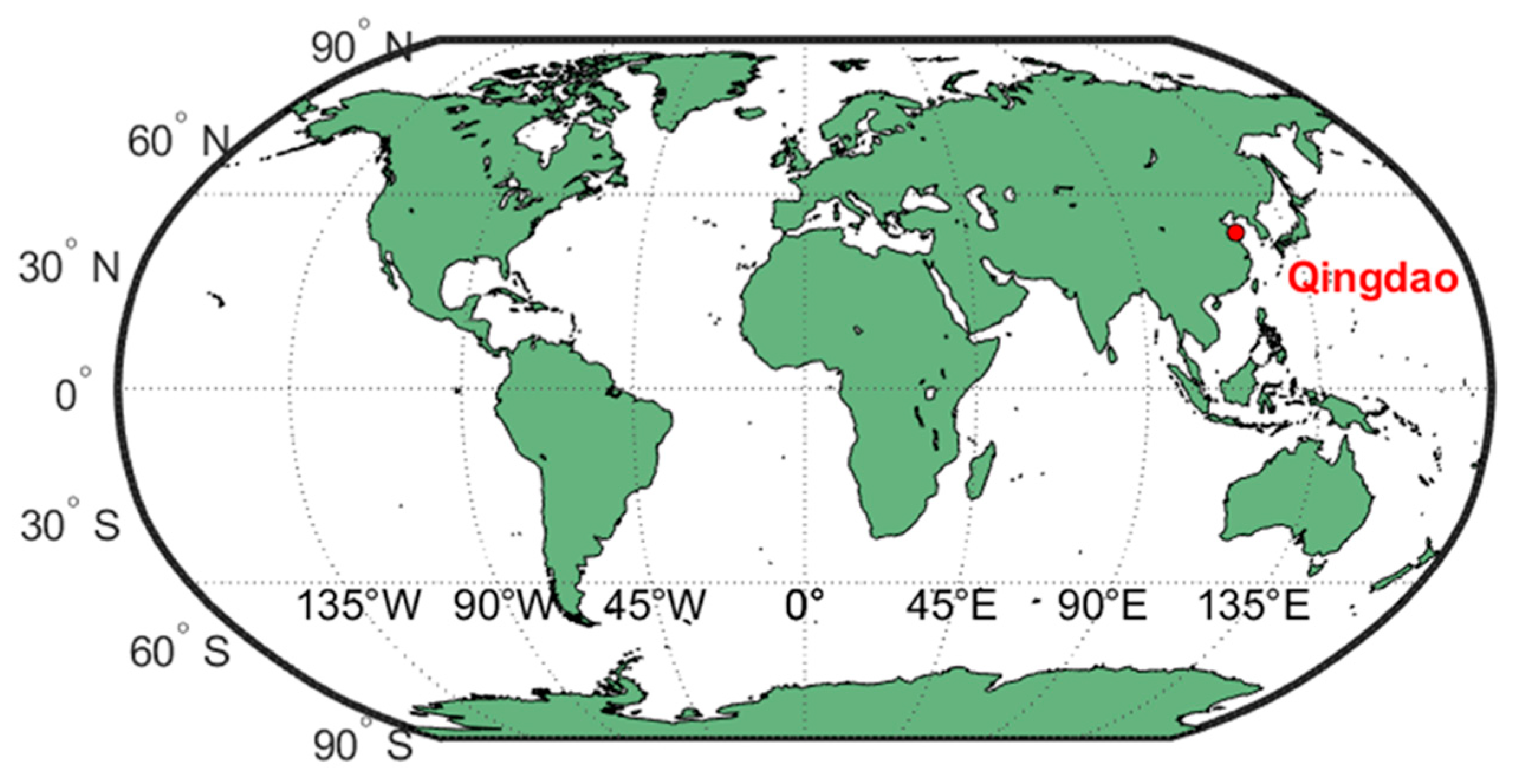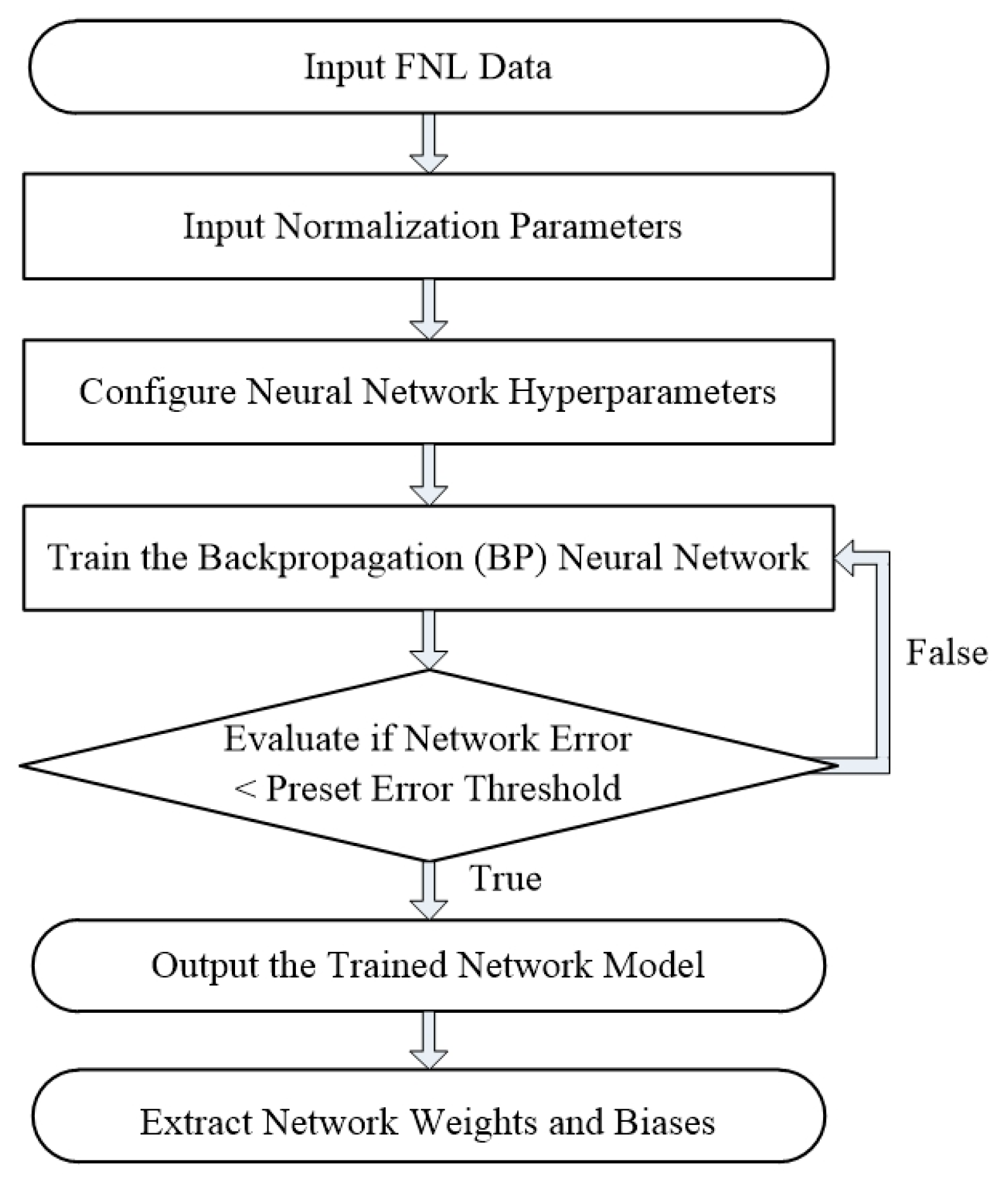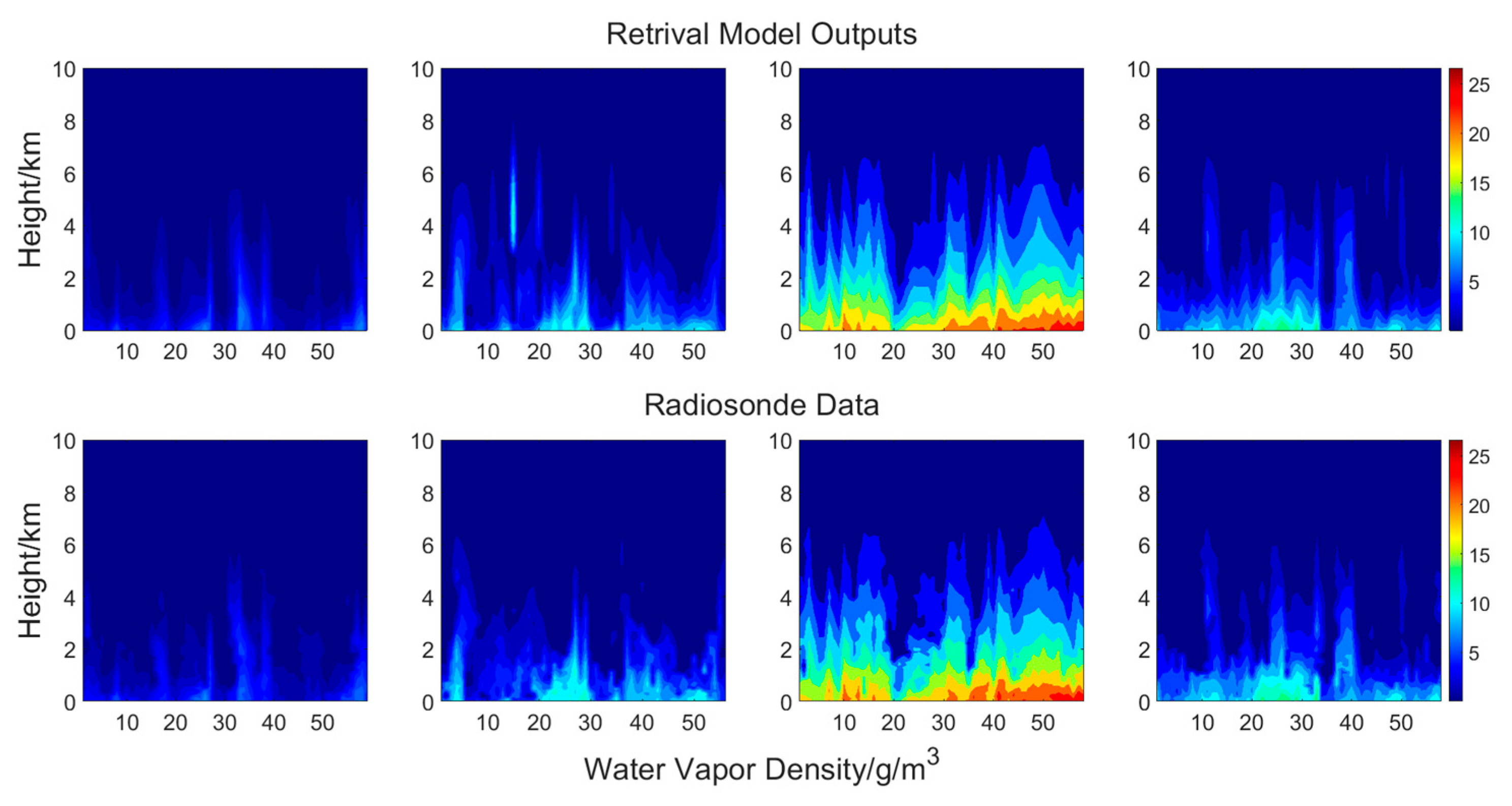Feasibility Study of Microwave Radiometer Neural Network Modeling Method Based on Reanalysis Data
Abstract
1. Introduction
2. Data Sources and Research Methods
2.1. Data Sources
2.2. Retrieval Method
2.2.1. Brightness Temperature Forward Modeling
2.2.2. Neural Network Training
2.3. Accuracy Analysis Method
- (1)
- Vertical stratification diagnosis: Calculate the RMSE, MAE, and Bias of each height layer of the 83 layers layer by layer.
- (2)
- Seasonal assessment: For each independent month model (January, April, July, and October represent winter, spring, summer, and autumn), the error of the entire elevation layer from 0 to 10,000 m of all time periods in each month is statistically analyzed to quantify the seasonal variation characteristics.
- (3)
- Total performance test: Integrate the observation data of all time periods and all heights over four months, and calculate the comprehensive error index of all time periods and heights to evaluate the universality of the model.
3. Results and Analysis
3.1. Seasonal Analysis of Retrieval Results
3.1.1. Analysis of Retrieval Results of Temperature
3.1.2. Analysis of Retrieval Results of Water Vapor Density
3.1.3. Analysis of Retrieval Results of Relative Humidity
3.1.4. Analysis of Retrieval Results of IWV
3.2. The Statistical Result of Root Mean Square Error
4. Conclusions
- (1)
- The vertical error distribution indicates that temperature and humidity errors increase with altitude in each season. The error in water vapor density increases rapidly from the surface to 1 km, then gradually decreases. Temperature and relative humidity errors increase most rapidly below 2 km.
- (2)
- The retrieval performance of different meteorological variables exhibits seasonal variations. The retrieval accuracy of temperature profiles is highest in summer and lowest in spring. The relative humidity profile also performs best in summer and worst in winter. However, the retrieval accuracy of water vapor density profiles and IWV is best in winter and worst in summer. This is due to enhanced radiation scattering by large water droplets in the summer atmosphere, which introduces measurement errors in brightness temperature. Additionally, large variations in the humidity field complicate the retrieval process. In winter and spring, low-level inversions are more prominent, with substantial variations in the thickness and intensity of the inversion layer, making it challenging to retrieve refined temperature profiles.
- (3)
- The results of the neural network retrieval based on FNL reanalysis data are generally consistent with the radiosonde data. The comprehensive statistics of the entire layer show that in the near surface layer (0–2 km) and mid-upper layer (>2 km), the RMSE of the temperature profile retrieve results are 1.15 °C and 2.05 °C respectively, and the RMSE of the relative humidity are 14.01% and 20.79% respectively. The RMSE of water vapor densities are 1.25 g/m3 and 0.62 g/m3 respectively and RMSE of IWV is 1.37 mm. Overall, the retrieval results exhibit small errors, demonstrating that this method is reliable and practical for atmosphere observing.
Author Contributions
Funding
Institutional Review Board Statement
Informed Consent Statement
Data Availability Statement
Acknowledgments
Conflicts of Interest
Abbreviations
| BP | Back Propagation |
| ERA5 | ECMWF Reanalysis 5th Generation |
| FNL | Final Reanalysis |
| GDAS | Global Data Assimilation System |
| IWV | Integrated Water Vapor |
| LSTM | Long Short Term Memory |
| MAE | Mean Absolute Error |
| NCEP | National Centers for Environmental Prediction |
| RBF | Radial Basis Function |
| RD | Relative Deviation |
| RMSE | Root Mean Square Error |
References
- Ware, R.H.; Solheim, F.S. Microwave profiling of atmospheric temperature, humidity, and cloud liquid water. Mirow. Remote Sens. Atmos. Environ. 2000, 4152, 292–302. [Google Scholar]
- Zhang, X.F.; Wang, Z.C.; Mao, J.J.; Wang, Z.W.; Zhang, D.M.; Tao, F. Experiments on improving temperature and humidity profile retrieval for ground-based microwave radiometer. J. Appl. Meteorol. Sci. 2020, 31, 385–396. (In Chinese) [Google Scholar]
- Zhang, W.G.; Xu, G.R.; Yan, G.P.; Li, N.; Huang, Z.Y.; Feng, G.L. Comparative analysis of microwave radiometer and radiosonde data. Meteorol. Sci. Technol. 2014, 42, 737–741. (In Chinese) [Google Scholar]
- Yuan, S.; Cheng, H.; Wang, D.Y.; Zhou, J. Comparative analysis on meteorological parameters of sounding data and model-generated sounding data. J. Meteorol. Sci. 2012, 32, 62–67. (In Chinese) [Google Scholar]
- Lei, L.F.; Lu, J.P.; Zhu, L.; Wu, H. Atmospheric remote sensing using multi-channel ground-based microwave radiometer. J. Remote Sens. 2014, 18, 180–191. (In Chinese) [Google Scholar] [CrossRef]
- Churnside, J.H.; Stermitz, T.A.; Schroeder, J.A. Temperature profiling with neural network inversion of microwave radiometer data. J. Atmos. Ocean. Technol. 1994, 11, 105–109. [Google Scholar] [CrossRef]
- Smith, W.L.; Woolf, H.M. The use of eigenvectors of statistical covariance matrices for interpreting satellite sounding radiometer observations. J. Atmos. Sci. 1976, 33, 1127–1140. [Google Scholar] [CrossRef]
- Li, Z.; Li, J.; Menzel, W.P.; Nelson, J.P., III; Schmit, T.J.; Weisz, E.; Ackerman, S.A. Forecasting and nowcasting improvement in cloudy regions with high temporal GOES sounder infrared radiance measurements. J. Geophys. Res. Atmos. 2009, 114, D09216. [Google Scholar] [CrossRef]
- Cao, X.F.; Li, X.Y.; Luo, Q.; Liu, S.H.; Li, P.; Liu, X. Review of temperature profile inversion of satellite-borne infrared hyperspectral sensors. Natl. Remote Sens. Bull. 2021, 25, 577–598. (In Chinese) [Google Scholar]
- Cadeddu, M.P.; Turner, D.D.; Liljegren, J. A neural network for real-time retrievals of PWV and LWP from Arctic millimeter-wave ground-based observations. IEEE Trans. Geosci. Remote 2009, 47, 1887–1900. [Google Scholar] [CrossRef]
- Solheim, F.; Godwin, J.R.; Westwater, E.R.; Han, Y.; Keihm, S.J.; Marsh, K.; Ware, R. Radiometric profiling of temperature, water vapor and cloud liquid water using various inversion methods. Radio Sci. 1998, 33, 393–404. [Google Scholar] [CrossRef]
- Fan, X.; Huang, Y.; Leng, W.N.; Zhang, B.D.; Zhang, W.Y. Inversion of ground-based microwave radiometer measurements using radial basis function neural network. J. Meteorol. Environ. 2020, 36, 62–69. (In Chinese) [Google Scholar]
- Zhou, G.J.; Yang, Z.P.; Peng, J.; Yang, L.; Tao, F.; Mao, J.J. Humidity Profile Inversion of Ground Based Microwave Radiometer Based on LSTM. Meteorol. Sci. Technol. 2022, 50, 21–29. [Google Scholar] [CrossRef]
- Liu, Y.Y.; Mao, J.T.; Liu, J.; Li, F. Research of BP neural network for microwave radiometer remote sensing retrieval of temperature, relative humidity, cloud liquid water profiles. Plateau Meteorol. 2010, 29, 1514–1523. (In Chinese) [Google Scholar]
- Yang, M.Y. Research on Atmospheric Parameter Retrieval Method Based on Ground-Based Microwave Radiometer. Master’s Thesis, Nanjing University of Science &Technology, Nanjing, China, 2023. [Google Scholar]
- Huang, X.Y.; Zhang, X.; Leng, L.; Li, F.; Fan, Y.W. Study on retrieval methods with MonoRTM for microwave radiometer measurements. Meteorol. Sci. Technol. 2013, 33, 138–145. (In Chinese) [Google Scholar]
- Valjarević, A.; Filipović, D.; Valjarević, D.C.; Milanović, M.; Milošević, S.; Živić, N.; Lukić, T. GIS and remote sensing techniques for the estimation of dew volume in the Republic of Serbia. Meteorol. Appl. 2020, 27, e1930. [Google Scholar] [CrossRef]
- Zhao, T.B.; Fu, C.B.; Ke, Z.J.; Guo, W.D. Global atmosphere reanalysis datasets: Current status and recent advances. Adv. Earth Sci. 2010, 25, 241–254. (In Chinese) [Google Scholar]
- Hersbach, H.; Bell, B.; Berrisford, P.; Hirahara, S.; Horányi, A.; Muñoz-Sabater, J.; Nicolas, J.; Peubey, C.; Radu, R.; Schepers, D.; et al. The ERA5 global reanalysis. Q. J. R. Meteorol. Soc. 2020, 146, 1999–2049. [Google Scholar] [CrossRef]
- Hayes, L.; Stocks, M.; Blakers, A. Accurate long-term power generation model for offshore wind farms in Europe using ERA5 reanalysis. Energy 2021, 229, 120603. [Google Scholar] [CrossRef]
- Gleixner, S.; Demissie, T.; Diro, G.T. Did ERA5 Improve temperature and precipitation reanalysis over East Africa? Atmosphere 2020, 11, 996. [Google Scholar] [CrossRef]
- Carvalho, D.; Rocha, A.; Gómez, G.M.; Silva, S.C. Comparison of reanalyzed, analyzed, satellite-retrieved and NWP modelled winds with buoy data along the Iberian Peninsula coast. Remote Sens. Environ. Interdiscip. J. 2014, 152, 480–492. [Google Scholar] [CrossRef]
- Hu, L.H.; Jiang, H.L.; Wang, H. Prelimiary application of ERA5 reanalysis data to retrieval method of microwave radiometer. Meteorol. Sci. Technol. 2023, 52, 163–172. [Google Scholar]
- Mangsuer, A.; Xiao, J.; Sun, M.; Yang, H. Comparative analysis on the applicability of ERA5 and FNL data in Xinjiang. Plateau Mt. Meteorol. Res. 2024, 44, 142–150. [Google Scholar]
- Zhang, Y.; Chen, J.H.; Tang, B.Y. Numerical simulation of meteorological elements of a pollution episode in Sichuan Basin based on two reanalysis datasets. Acta Sci. Circum. 2020, 40, 3093–3102. [Google Scholar]
- Li, Q.; Wei, M.; Wang, Z.; Chu, Y.; Ma, L. Evaluation and correction of ground-based microwave radiometer observations based on NCEP-FNL data. Atmos. Clim. Sci. 2019, 9, 229–242. [Google Scholar] [CrossRef]
- Wang, Z.C.; Zhang, X.F.; Mao, J.J.; Wang, Z.C. Comparison analysis on detection performance of ground-based microwave radiometers under different weather conditions. J. Appl. Meteorol. Sci. 2018, 29, 282–295. (In Chinese) [Google Scholar]
- De Angelis, F.D.; Cimini, D.; Löhnert, U.; Caumont, O.; Haefele, A.; Pospichal, B.; Martinet, P.; Navas-Guzmán, F.; Klein-Baltink, H.; Dupont, J.C.; et al. Long-term observation minus background monitoring of ground-based brightness temperatures from a microwave radiometer network. Atmos. Meas. Tech. 2017, 10, 3947–3961. [Google Scholar] [CrossRef]
- Zhou, X.J. Atmospheric Microwave Radiation and Remote Sensing Principle; Science Press: Beijing, China, 1983; 178p. (In Chinese) [Google Scholar]
- Navas-Guzmán, F.; Kämpfer, N.; Haefele, A. Validation of brightness and physical temperature from two scanning microwave radiometers in the 60GHz O2 band using radiosonde measurements. Atmos. Meas. Tech. 2016, 9, 4587–4600. [Google Scholar] [CrossRef]
- Clough, S.A.; Iacono, M.J.; Moncet, J.L. Line-by-line calculations of atmospheric fluxes and cooling rates: Application to water vapor. J. Geophys. Res. Atmos. 1992, 97, 15761–15785. [Google Scholar] [CrossRef]
- Clough, S.A.; Iacono, M.J. Line-by-line calculation of atmospheric fluxes and cooling rates: 2. Application to carbon dioxide, ozone, methane, nitrous oxide and the halocarbons. J. Geophys. Res. Atmos. 1995, 100, 16519–16535. [Google Scholar] [CrossRef]
- Egorov, D.P.; Verina, Y.V.; Kravchenko, O.V. Development of neural network approach for reconstructing the atmospheric humidity profile form ground-based microwave radiometer-spectrometer data. In Proceedings of the Photonics & Electromagnetics Research Symposium (PIERS), Chengdu, China, 21–25 April 2024. [Google Scholar] [CrossRef]
- Cao, M.; Wang, B.; Yang, Z.; Zhang, Y.M. Data comparison between ground-based microwave radiometer and radiosonde. J. Shaanxi Meteorol. 2021, 5, 47–54. (In Chinese) [Google Scholar]
- Bedoya-Velásquez, A.E.; Navas-Guzmán, F.; de Arruda Moreira, G.; Román, R.; Cazorla, A.; Ortiz-Amezcua, P.; Benavent-Oltra, J.A.; Alados-Arboledas, L.; Olmo-Reyes, F.J.; Foyo-Moreno, I.; et al. Seasonal analysis of the atmosphere during five years by using microwave radiometry over a mid-latitude site. Atmos. Res. 2019, 218, 78–89. [Google Scholar] [CrossRef]
- Renju, R.; Suresh Raju, C.; Mishra, M.K.; Mathew, N.; Rajeev, K.; Moorthy, K.K. Atmospheric boundary layer characterization using multiyear ground-based microwave radiometric observations over a tropical coastal station. IEEE Trans. Geosci. Remote Sens. 2017, 55, 6877–6882. [Google Scholar] [CrossRef]












| Equipment | QFW-6000 | |
|---|---|---|
| Parameters | ||
| Detection range | 0~10 km | |
| Technical system | Mixing frequency detection | |
| Brightness temperature sensitivity | Water vapor channel ≤0.2 K (1 s integration) Oxygen channel ≤0.3 K (1 s integration) | |
| Measurement error of bright temperature | ≤1 K (RMS) | |
| Observe the bright temperature range | 0~400 K | |
| Frequency range and number of channels | 22~32 GHz: 8 vapor channels 52~59 GHz: 8 temperature channels | |
| Long-term stability of bright temperature | ≤0.1 K/month | |
| Sampling frequency | ≤2 min(Fastest 10 s) | |
| Observation mode | zenith observation | |
| Parameter Type | Value |
|---|---|
| The number of neurons in the input layer | 20 |
| The number of neurons in the hidden layer | 41 |
| The number of neurons in the output layer | 83 |
| The number of training samples | 13,140 |
| The number of validation samples | 1460 |
| The number of test samples | 213 |
| Maximum number of iterations | 5000 |
| Month | January | April | July | October | Total Error | |
|---|---|---|---|---|---|---|
| Variable | ||||||
| Temperature (°C) (0~2 km) | RMSE | 1.07 | 1.34 | 0.95 | 1.20 | 1.15 |
| MAE | 0.65 | 0.81 | 0.57 | 0.72 | 0.69 | |
| Bias | −0.044 | 0.005 | −0.0005 | −0.036 | −0.02 | |
| Temperature (°C) (>2 km) | RMSE | 2.09 | 2.34 | 1.51 | 2.26 | 2.05 |
| MAE | 1.80 | 2.06 | 1.25 | 1.88 | 1.75 | |
| Bias | 0.76 | −1.41 | −0.56 | −0.83 | −0.51 | |
| Water vapor density (0~2 km) | RMSE | 0.61 | 1.57 | 1.61 | 1.21 | 1.25 |
| MAE | 0.44 | 1.19 | 1.15 | 0.98 | 0.94 | |
| Bias | −0.13 | −0.68 | −0.40 | −0.53 | −0.44 | |
| Water vapor density (>2 km) | RMSE | 0.26 | 1.02 | 0.75 | 0.46 | 0.62 |
| MAE | 0.15 | 0.46 | 0.56 | 0.32 | 0.37 | |
| Bias | 0.06 | 0.30 | 0.15 | 0.15 | 0.16 | |
| Relative humidity (0~2 km) | RMSE | 17.65 | 15.44 | 9.99 | 13.06 | 14.01 |
| MAE | 12.59 | 12.28 | 7.47 | 10.75 | 10.77 | |
| Bias | −5.37 | −5.96 | −2.23 | −4.17 | −4.43 | |
| Relative humidity (>2 km) | RMSE | 20.87 | 22.05 | 18.64 | 21.49 | 20.79 |
| MAE | 15.96 | 17.51 | 14.63 | 17.03 | 16.28 | |
| Bias | 10.19 | 7.13 | 2.49 | 6.50 | 6.58 | |
| IWV | RMSE | 0.65 | 1.31 | 2.16 | 1.20 | 1.37 |
| MAE | 0.43 | 0.89 | 1.59 | 0.91 | 0.95 | |
| Bias | 0.09 | 0.13 | 0.19 | 0.16 | 0.14 |
Disclaimer/Publisher’s Note: The statements, opinions and data contained in all publications are solely those of the individual author(s) and contributor(s) and not of MDPI and/or the editor(s). MDPI and/or the editor(s) disclaim responsibility for any injury to people or property resulting from any ideas, methods, instructions or products referred to in the content. |
© 2025 by the authors. Licensee MDPI, Basel, Switzerland. This article is an open access article distributed under the terms and conditions of the Creative Commons Attribution (CC BY) license (https://creativecommons.org/licenses/by/4.0/).
Share and Cite
Liu, X.; Zhu, Q.; Dong, X.; Chen, H.; Shu, T.; Wang, W.; Xu, B. Feasibility Study of Microwave Radiometer Neural Network Modeling Method Based on Reanalysis Data. Atmosphere 2025, 16, 1194. https://doi.org/10.3390/atmos16101194
Liu X, Zhu Q, Dong X, Chen H, Shu T, Wang W, Xu B. Feasibility Study of Microwave Radiometer Neural Network Modeling Method Based on Reanalysis Data. Atmosphere. 2025; 16(10):1194. https://doi.org/10.3390/atmos16101194
Chicago/Turabian StyleLiu, Xuan, Qinglin Zhu, Xiang Dong, Houcai Chen, Tingting Shu, Wenxin Wang, and Bin Xu. 2025. "Feasibility Study of Microwave Radiometer Neural Network Modeling Method Based on Reanalysis Data" Atmosphere 16, no. 10: 1194. https://doi.org/10.3390/atmos16101194
APA StyleLiu, X., Zhu, Q., Dong, X., Chen, H., Shu, T., Wang, W., & Xu, B. (2025). Feasibility Study of Microwave Radiometer Neural Network Modeling Method Based on Reanalysis Data. Atmosphere, 16(10), 1194. https://doi.org/10.3390/atmos16101194





